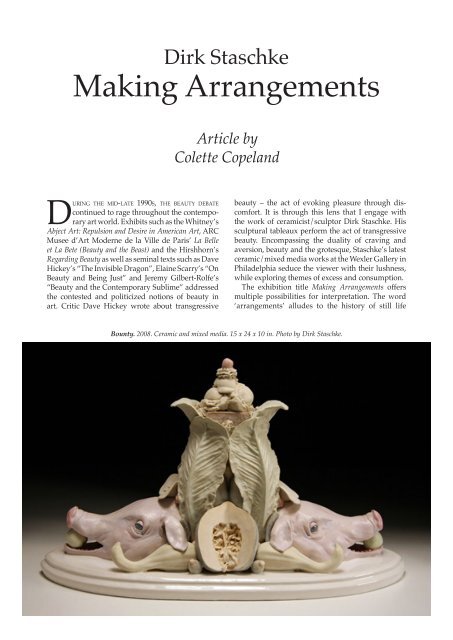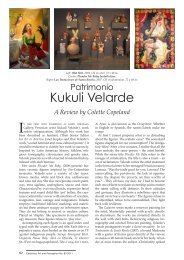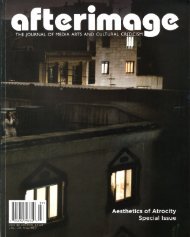Dirk Staschke--Making Arrangements Exhibit ... - Colette Copeland
Dirk Staschke--Making Arrangements Exhibit ... - Colette Copeland
Dirk Staschke--Making Arrangements Exhibit ... - Colette Copeland
You also want an ePaper? Increase the reach of your titles
YUMPU automatically turns print PDFs into web optimized ePapers that Google loves.
<strong>Dirk</strong> <strong>Staschke</strong><br />
<strong>Making</strong> <strong>Arrangements</strong><br />
During the mid-late 1990s, the beauty debate<br />
continued to rage throughout the contemporary<br />
art world. <strong>Exhibit</strong>s such as the Whitney’s<br />
Abject Art: Repulsion and Desire in American Art, ARC<br />
Musee d’Art Moderne de la Ville de Paris’ La Belle<br />
et La Bete (Beauty and the Beast) and the Hirshhorn’s<br />
Regarding Beauty as well as seminal texts such as Dave<br />
Hickey’s “The Invisible Dragon”, Elaine Scarry’s “On<br />
Beauty and Being Just” and Jeremy Gilbert-Rolfe’s<br />
“Beauty and the Contemporary Sublime” addressed<br />
the contested and politicized notions of beauty in<br />
art. Critic Dave Hickey wrote about transgressive<br />
Article by<br />
<strong>Colette</strong> <strong>Copeland</strong><br />
beauty – the act of evoking pleasure through discomfort.<br />
It is through this lens that I engage with<br />
the work of ceramicist/sculptor <strong>Dirk</strong> <strong>Staschke</strong>. His<br />
sculptural tableaux perform the act of transgressive<br />
beauty. Encompassing the duality of craving and<br />
aversion, beauty and the grotesque, <strong>Staschke</strong>’s latest<br />
ceramic/mixed media works at the Wexler Gallery in<br />
Philadelphia seduce the viewer with their lushness,<br />
while exploring themes of excess and consumption.<br />
The exhibition title <strong>Making</strong> <strong>Arrangements</strong> offers<br />
multiple possibilities for interpretation. The word<br />
‘arrangements’ alludes to the history of still life<br />
Bounty. 2008. Ceramic and mixed media. 15 x 24 x 10 in. Photo by <strong>Dirk</strong> <strong>Staschke</strong>.
painting, specifically vanitas paintings from Northern<br />
Europe in the late 16th and early 17th centuries.<br />
Characterized by sumptuous displays of flora, fauna<br />
and food, artists such as Dutch painter Abraham van<br />
Beyeren (1620-1690) infused the vanitas paintings with<br />
rich allegorical and religious symbolism. Best known<br />
for his banquet still lifes, Beyeren’s paintings signify<br />
life’s temporality and the emptiness of pleasure. <strong>Dirk</strong><br />
<strong>Staschke</strong>’s works Commemoration and Bounty both celebrate<br />
and subvert the vanitas still life tradition.<br />
Stagger. 2009. Ceramic and mixed media.<br />
20 x 16 x 16 in. Photo by <strong>Dirk</strong> <strong>Staschke</strong>.<br />
Commemoration is comprised of two pig heads elegantly<br />
placed on a platter, surrounded by cabbage<br />
leaves, calla lilies, dogwood flowers, split papayas,<br />
eggplants and cucumbers topped with a richly decorated<br />
cake. Beautifully and meticulously sculpted,<br />
the lavish display suggests an abundant celebration.<br />
Upon closer examination, one notices the decorative<br />
ribbon woven throughout the elaborate arrangement<br />
is in actuality – entrails. The voluptuous organic<br />
forms of the eggplants, gourds and split papayas<br />
elicit a sexual connotation. The pigs exude uncanny<br />
human-like expressions. One seems content with his<br />
100<br />
Ceramics: Art and Perception No. 76 2009<br />
fate, while the other seems less resigned, perhaps<br />
a bit melancholy. The word ‘commemorate’ means<br />
to honour. The duality present in this ceramic work<br />
advocates both a tribute to and a discomfort with the<br />
perverse plenitude.<br />
Similar in subject matter, the work Bounty revels in<br />
its refined opulence. Lacking the gluttonous excess<br />
present in Commemoration, the composition’s simplicity<br />
bursts with sexual eroticism. The two pigs in<br />
this work appear freshly killed. Their blue cataract<br />
eyes gaze directly at the viewer. <strong>Staschke</strong> painstakingly<br />
painted the pig heads in oils resulting in eerily<br />
life-like skin tones. These pigs have teeth. Topped<br />
with whipped cream and a cherry, the work both<br />
attracts and repulses.<br />
Another possible interpretation for the exhibition<br />
Above: Propagation. 2008. Ceramic and mixed media.<br />
20 x 20 x 7 in.<br />
Below: Dominion. 2009. Ceramic and mixed media.<br />
8 x 10 x 8 in. Photos by <strong>Dirk</strong> <strong>Staschke</strong>.
title, <strong>Making</strong> <strong>Arrangements</strong> is the reference to weddings<br />
and funerals and the relationship to food in<br />
these cultural rituals. Whether celebrating life or<br />
death, food serves as the nucleus, functioning as a<br />
source of sustenance and comfort. Food also serves<br />
as a cultural symbol, denoting social class and economic<br />
prosperity. Weddings and funerals are occasions<br />
where extravagance and over-consumption<br />
are condoned and accepted as part of the traditional<br />
ritual. <strong>Staschke</strong>’s ceramic/mixed media works<br />
Propagation and Stagger examine the gluttony and<br />
greed inherent in our culture.<br />
In Propagation, six ceramic chickens sit on a starshaped<br />
platter. Layers of oil paint fused with resin<br />
result in a hyper-realistic chicken complete with delicately<br />
blue-veined, pebbly skin. Innards removed,<br />
Discopia. 2009. Ceramic and mixed media.<br />
29 x 16 x 12 in. Photo by <strong>Dirk</strong> <strong>Staschke</strong>.<br />
the cavernous hole trimmed in a layer of fat resembles<br />
a mouth with teeth. Ready to devour or be<br />
devoured? <strong>Staschke</strong> sculpts the original chicken in<br />
clay. Next he makes a master mold, which allows<br />
for reproduction or propagation of the chickens. The<br />
technical process further emphasizes our culture’s<br />
desire for more. The artist states, “Like an extravagant<br />
meal, the arrangements we make to further our<br />
desires can come with painful unintended consequences.”<br />
Perhaps he is suggesting the ramifications<br />
of our over-consumption such as factory farms, environmental<br />
instability and disease.<br />
Stagger depicts a precariously balanced china<br />
teacup, perched on top of mountainous layers of<br />
pastries. Contingent upon the teetering support<br />
of mass-produced empty calories, the lone object<br />
Cataclysm. 2009. Ceramic and mixed media.<br />
21 x 18 x 10 in. Photo by <strong>Dirk</strong> <strong>Staschke</strong>.<br />
of refinement’s stature seems dubious at best.<br />
Lasciviously oozing custard and crème, the sicklysweet<br />
éclairs and donuts appear to be sliding off<br />
of their plates. The paradox lies in the fact that the<br />
sculpture is solid. Suspended in its careening form,<br />
the pastries look cemented together with a creamy,<br />
confectionary glaze.<br />
<strong>Staschke</strong> employs a similar technique in Cataclysm,<br />
where a tower of croissants, cannolis, pirouettes, cupcakes,<br />
ice cream and brownies slope off-kilter, on<br />
the verge of collapse. Supporting the tower are two<br />
black forest cakes covered with shiny red glazed<br />
cherries. The same cherries drip from a piece of pie at<br />
the top of the sculpture. From a distance, one cannot<br />
Ceramics: Art and Perception No. 76 2009 101
help but ‘read’ the work as a large phallic symbol.<br />
This work reminds me of an image of Pamela<br />
Anderson entitled, Stars Caught Chowing Down –<br />
Pamela Anderson has breakfast in Malibu on April 1,<br />
2009. Anderson symbolizes the epitome of excessive<br />
cultural consumption. I am not speaking about her<br />
as an individual, but what she represents iconically<br />
– idealized beauty gone awry. <strong>Staschke</strong> states that<br />
people consume ideas as well as products and that<br />
eating becomes a metaphor for material consumption.<br />
Caught with her mouth wide-open in mid-bite, this<br />
image of Anderson could serve as Hickey’s advertisement<br />
for transgressive beauty.<br />
The only work in the exhibition not related to food<br />
is entitled, Premonition. An arm (sans skin) extends<br />
from the wall exposing red tendons and muscles. A<br />
taxidermied white-eared bulbu bird perches on the<br />
hand. At once beautiful and grotesque, the work<br />
speaks to the transience and mystery of life. It relates<br />
to the vanitas paintings, which featured human skulls<br />
as a symbol of death. In a conversation with the artist,<br />
I find out that this is his favourite work. As he<br />
describes it, “It’s the dot on an exclamation point”. I<br />
consider the possibility that this is his most autobiographical<br />
work to date. Premonition challenges us to<br />
confront our own mortality as well as our tenuous<br />
relationship to nature.<br />
The strength of <strong>Dirk</strong> <strong>Staschke</strong>’s work and the<br />
exhibition as a whole resides in the artist’s ability to<br />
create a symbiosis between the conceptual and technical<br />
aesthetics. The sculptures resonate beyond the<br />
art object, asserting themselves in a dialogue which<br />
questions the social/political culture in which we<br />
live. Contextualising the work within our current<br />
102<br />
Ceramics: Art and Perception No. 76 2009<br />
economic and political climate, I think of Obama’s<br />
words from his Presidential inauguration, “To those<br />
nations like ours that enjoy relative plenty, we say<br />
we can no longer afford indifference to the suffering<br />
outside our borders, nor can we consume the<br />
world’s resources without regard to effect.” Obama<br />
has called upon the nation to sacrifice, eliminating<br />
wastefulness. <strong>Dirk</strong> <strong>Staschke</strong>’s work reminds us of<br />
the consequences of our desires.<br />
Footnotes:<br />
1. Viso. Olga M. “Beauty and Its Dilemmas”, Regarding<br />
Beauty, Smithsonian Institution, 1999, p. 97.<br />
2. http://www.britannica.com/EBchecked/top<br />
ic/623056/vanitas http://www.metmuseum.org/<br />
toah/hd/nstl/hd_nstl.htm<br />
3. Artist statement, gallery press release.<br />
www.wexlergallery.com<br />
4. Artist statement, gallery press release.<br />
5. Phone conversation with <strong>Dirk</strong> <strong>Staschke</strong> on<br />
7 April, 2009.<br />
6. Quote from President Obama’s inaugural speech.<br />
http://www.msnbc.msn.com/id/28751183/page/2/<br />
Premonitions. 2008. Ceramic, taxidermied bird and mixed media.<br />
13 x 24 x 8 in. Photo by <strong>Dirk</strong> <strong>Staschke</strong>.<br />
<strong>Colette</strong> <strong>Copeland</strong> is a multi-media visual artist whose work<br />
examines issues surrounding gender and contemporary culture.<br />
She teaches in the Critical Writing Department at the University of<br />
Pennsylvania and is a regular contributor to Exposure Journal and<br />
Afterimage Magazine. She lives in Media, Pennsylvania US with<br />
her husband and two children. Her work can be seen at www.<br />
colettecopeland.com and http://colettecopeland.blogspot.com.









